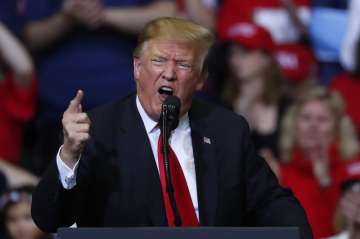Donald Trump says US was 'cocked and loaded' to strike Iran | 10 Points
President Donald Trump said Friday the U.S. was “cocked and loaded” to retaliate against Iran for downing an unmanned American surveillance drone, but he canceled the strikes 10 minutes before they were to be launched after being told 150 people could die.

President Donald Trump said Friday the U.S. was “cocked and loaded” to retaliate against Iran for downing an unmanned American surveillance drone, but he canceled the strikes 10 minutes before they were to be launched after being told 150 people could die. Trump’s tweeted statement raised several questions, including how he could have learned about casualties only minutes before the operation when that information typically would be provided much earlier. His tweet was the latest indication that he does not want to escalate the U.S. clash with Tehran, though he didn’t rule out future strikes.
He said U.S. economic sanctions are crippling the Iranian economy, more are being added and he insisted anew that the U.S. would never allow Iran to have a nuclear weapon
Here are 10 Points:
1. After days of harsh words against the United States, Iran also seemed to be tamping down its rhetoric. Gen. Amir Ali Hajizadeh, the head of the Revolutionary Guard’s aerospace division, told reporters on Friday that a U.S. spy plane with around 35 crew members was flying close to the unmanned U.S. Navy RQ-4A Global Hawk that was shot down, but that Iran chose not to target the manned aircraft. Separately, he told Iranian state TV that Iran warned the drone several times before downing it with a missile.
2. Late Thursday, the Federal Aviation Administration barred American-registered aircraft from flying over parts of the Persian Gulf and the Gulf of Oman, and several major airlines from around the world on Friday began rerouting their flights , including British Airways, Australia’s Qantas, Germany’s Lufthansa and the Dutch carrier KLM.
ALSO READ | Global airlines reroute flights after Iran downs US drone
3. In a lengthy tweet, Trump defended his stance on Iran amid criticism from Democrats who accuse him of having no strategy. He said he pulled out of the 2015 Iran nuclear deal, which gave Tehran sanctions relief in exchange for pledges to rein in its nuclear program, because the agreement only temporarily blocked Iran from having nuclear weapons. Trump said the nuclear deal also did not stem Iran’s support of militant groups or restrain its ballistic missile program.
4. He said his exit from the deal and the re-imposition of sanctions on Iran has crippled its economy. “Now they are Bust!” Trump tweeted and then outlined his reasons for canceling the strikes. “We were cocked & loaded to retaliate last night on 3 different sights when I asked, how many will die. 150 people, sir, was the answer from a General. 10 minutes before the strike I stopped it.”
5. He added that those deaths would not be a proportionate response to the downing of an unmanned drone.
6. “I am in no hurry,” he said. “Sanctions are biting & more added last night. Iran can NEVER have Nuclear Weapons, not against the USA, and not against the WORLD!”
7. The overnight events, however, were a stark reminder of the serious risk of military conflict between U.S. and Iranian forces as the Trump administration combines its “maximum pressure” campaign of economic sanctions with a buildup of American troops in the region. As tensions have mounted in recent weeks, there have been growing fears that either side could make a dire miscalculation leading to war.
ALSO READ | United Airlines suspends New York/Newark-Mumbai flights
8. Airlines rerouted flights Friday to avoid airspace near the Strait of Hormuz after Iran shot down a U.S. military surveillance drone there and American aviation officials warned that commercial jetliners could be mistakenly attacked amid tensions between Tehran and Washington.
9. Local long-haul carriers Emirates and Etihad were among those that changed flight routes in an area that is home to major hubs of global air travel. That could further imperil the bottom lines of Gulf long-haul carriers, which already have faced challenges under the Trump administration.
10. The Persian Gulf ’s long-haul carriers already have been battered by Trump’s travel bans targeting predominantly Muslim countries, as well as an earlier ban on laptops in airplane cabins for Mideast carriers.
The Trump administration has been putting increasing economic pressure on Iran for more than a year. It reinstated punishing sanctions following Trump’s decision to pull the U.S. out of an international agreement intended to limit Iran’s nuclear program in exchange for relief from earlier sanctions.
Citing Iranian threats, the U.S. recently sent an aircraft carrier to the Persian Gulf region and deployed additional troops alongside the tens of thousands already there. All this has raised fears that a miscalculation or further rise in tensions could push the U.S. and Iran into an open conflict 40 years after Tehran’s Islamic Revolution.
ALSO READ | Trump orders military strike on Iran, withdraws later: What we know so far